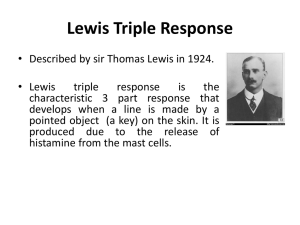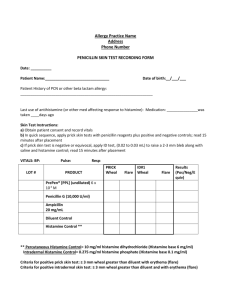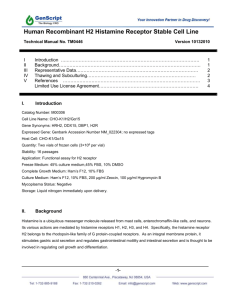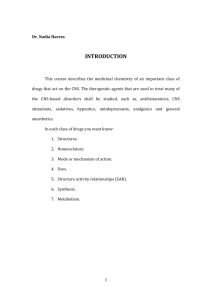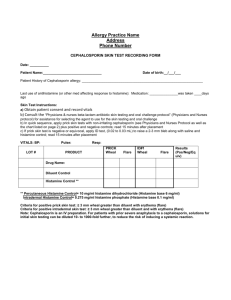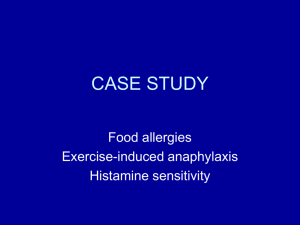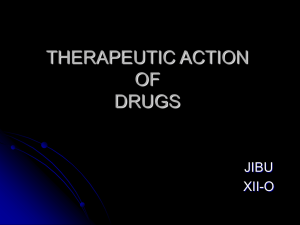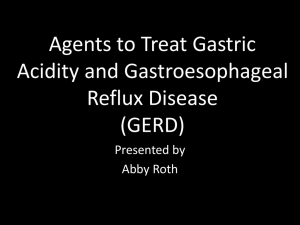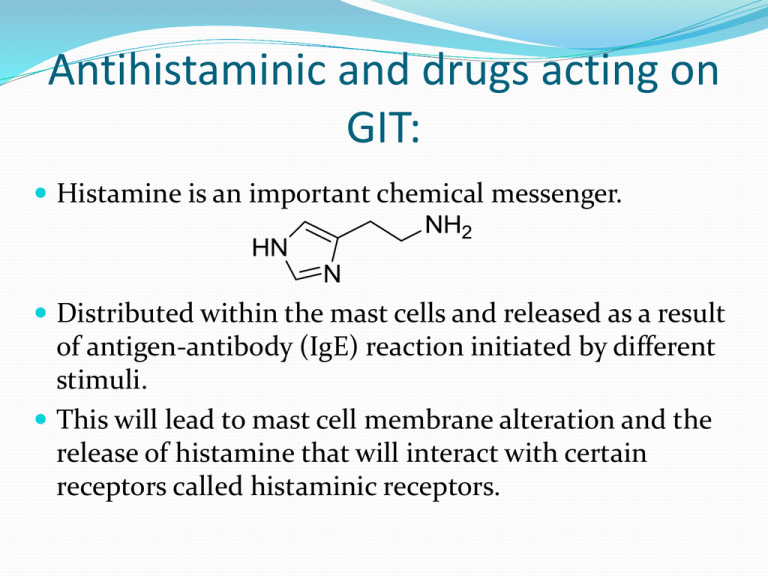
Antihistaminic and drugs acting on
GIT:
Histamine is an important chemical messenger.
Distributed within the mast cells and released as a result
of antigen-antibody (IgE) reaction initiated by different
stimuli.
This will lead to mast cell membrane alteration and the
release of histamine that will interact with certain
receptors called histaminic receptors.
Histamine
Plays an important role as a stimulant of gastric
secretion from the parietal cells.
Has neurotransmission role in the CNS responsible
for:
Alertness.
Hormone release.
Feeding and drinking.
Sexual behavior.
Analgesia.
Histaminic receptors
Of Four types:H1 to H4.
H1-activation:
Smooth muscle contraction in GIT, uterus and bronchi.
Relaxation of capillaries….. Increase permeability… results in edema.
H2-activation:
Gastric secretion.
Hypotension due to vascular dilatation.
H3-activation:
Most important in CNS: regulate histamine in the body, by inhibiting
the further synthesis of histamine.
H4-activation:
regulate the levels of white blood cell release from bone marrow.
Histamine
It has two basic centers.
At acidic pH it forms the di-cation compound
At physiological pH it presents as monocation.
Anti-allergic agents
Allergy: is the physiological response to a foreign
chemical or physical condition… cause symptoms such
as hay fever, pruritus, dermatitis, rashes, and
anaphylactic shock (systemic allergic reaction that
may lead to death).
Anti-allergic agents block some of the action of
histamine.
Histamine as a lead:
SAR for histamine:
The amino group should be positively charged and
attached to at least one hydrogen atom.
It should have flexible chain between the amino and the
aromatic ring.
The heteroaromatic did not have to be imidazole.
All Histamine analogues did not show promising H1-
antagonist activity, they have shown either low agonist
or no activity.
H1-antagonists:
1.
Ethylenediamine derivatives:
Phenbenzamine was used as a model for the synthesis
of H1-antagonists using the general structure of
Ethylenediamine derivatives
R1 and R2 should be small (CH3) for maximum H1-
antagonist activity.
Ar1 and Ar2 can be benzene ring or any other isosteric
rings such as heterocycles.
One of the aromatic should be benzyl for better
activity which has P-substitution.
Ethylenediamine derivatives
Isosteric rings to benzene:
All H1-antagonists are dispensed as water soluble salts.
Bioisosterism
Bioisosteres are groups with similar physical and
chemical properties which produce almost the same
biological and pharmacological response or effect.
The aim of using such groups are:
Minimizing the possible side effects.
Prolong the duration of action.
Produce potent agents.
Increase physical and biological stability of drugs
Ethylenediamine derivatives
Examples:
Aminoalkyl ether analogues
Closely related to ethylenediamine derivatives.
Examples:
Cyclic analogues of ethylenediamine
They have mainly CNS depressant effects.
Main uses:
In allergy.
As antiemetic agents.
In motion sickness.
Cyclic analogues of ethylenediamine
• All have hydrophobic group attached to the terminal amino group for
better activity compared to ethylenediamine derivatives.
• They have a rigidified ethylenediamine structure.
• Lower incidence of drowsiness.
• They have antimuscarinic activity.
Propylamines
(monoaminoproprylamines)
Mainly have a phenyl and 2-pyridyl groups, and a
terminal dimethylamino moiety.
The hydrophobic linker should have either sp2 or sp3
carbons.
They are less sedating compared to the
ethylenediamine derivatives.
The S enantiomer is the most active form.
Propylamines
(monoaminoproprylamines)
H1-antagonists with decreased
sedative effects
The major side effect of H1-antagonists is sedation due
to the interaction with cerebral H1 and H3 -receptors.
Strategies to decrease sedation:
Increase selectivity to the peripheral compared to the
central H1-receptors.
increase polarity of classic H1-receptors to decrease the
ability to penetrate the BBB.
H1-antagonists with decreased
sedative effects
• these non-sedating antihistamines have greater receptor specificity,
lower penetration of blood-brain barrier, and are less likely to cause drowsiness
H2-antagonists: Anti-ulcer agents
H2-antagonists: Anti-ulcer agents
Gastric secretion in stomach is controlled by:
1. Acetylcholine: M3-activation which lead to the
production of acid.
2. Gastrin hormone: will be released from the G-cells in
the antrum … this will interact with Cck2 receptor in
the parietal cells to produce the gastric acid.
3. Histamine: will bind to the H2-receptors… gastric acid
production.
4. The proton pump: will pump the formed acid (H+) out
of the Parietal cells into the stomach lumen.
H2-antagonists: Anti-ulcer agents
The First approach in synthesizing H2-antagonists was
the use of Histamine as the lead compound to produce
antagonist activity.
Can be done by:
Adding extra hydrophobic group to the structure.
Varying the polar amino group.
Make extension to the ethyl linker between the amino
and the imidazole ring.
Histamine analogues:
Histamine analogues:
The next approach was to vary the polar groups in
histamine with other polar functional groups.
The first derivative was N-guanylhistamine:
Has a weak H2-antagonist (partial agonist).
The guanidine moiety has a positive charge at
physiological pH which will be distributed over the
three nitrogen atoms.
N-guanylhistamine as a lead
* The imidazole ring proofed to be important for both agonist and antagonist
binding. So the pka of this ring should be closer to the histamine one (5.74).
* The pka of imidazole from burimamide is 7.25 which means that around 40%
of the imidazole ring is ionized.
* The side chain of burimamide should be electron withdrawing to make the pka of
The ring close to 5.74.

